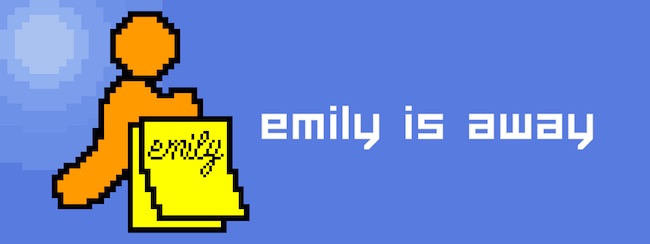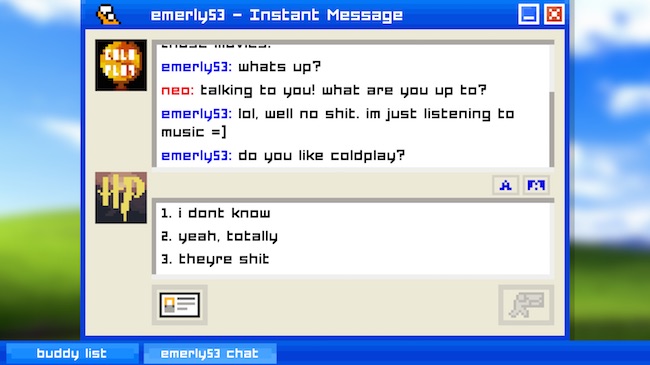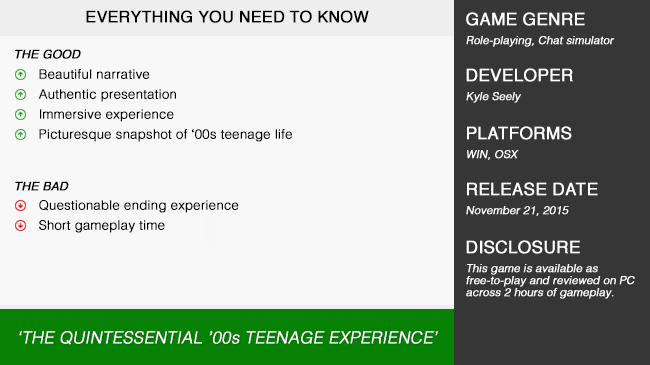
The year was 2002. I was 14 years old, and at that age the best way to spend your time was to bust out the 56K dial-up internet connection and jump on to MSN and talk until bedtime with your friends, randoms and most importantly – the person/people that you had a crush on. In this lies the premise of ‘Emily is Away’, a small title by a United States developer Kyle Seely, which was released two weeks ago on Steam.
Emily is Away starts in high school, where you log on to your computer and start talking to a girl named Emily, also known as emerly53. Being a purely text-driven game, the story is essentially a “Choose Your Own Adventure” with a number of dialogue options being available to choose from throughout the duration of your conversation with Emily. The real kicker for me, in an overwhelming wave of nostalgia, was being able to click on friends usernames in the chat menu. By doing so, you can access their profiles, which are littered with song lyrics from era-appropriate bands such as Coldplay and Snow Patrol, as well as quotes of such depth and sincerity that only someone in the wonder years of their youth can display.

I was completely blown away by the narrative direction of this game as it genuinely felt like I had opened a time portal to my life nearly ten years ago, of friends and times I barely even remember. Feeling that pang of heartache and youthful indiscretion is definitely a cornerstone of this game’s experience, and it sets about executing it perfectly in both subtle and bold ways. Remembering the nerves of confessing to a girl that you liked on MSN is something both unabashed and poignant in its own way, and is truly the master stroke of this piece. During my research, I did stumble across a lot of discussion regarding the ending of the game, though, I personally found it rather interesting. While I don’t want to give it away in the hopes that people will go away and play it, I’d love to hear what others who have played it think about the ending.
The design of the game is progressive, with there being five chapters spanning from 2002 until 2006; documenting from high school until the end of college. However, what resonated with me most and made this game feel so unique was how the dialogue selections played out. Sometimes, in fitting with the conversation – if you selected a somewhat “up front” dialogue option, your character would type it out and then pause, only to backtrack and erase what you said to word it differently. Just this small factor made the game so much more relatable and portrayed how starkly we filter ourselves sometimes in text-based conversations without perhaps always realising it.

While the gameplay was obviously limited for a text based game, this was also another area where I found Emily is Away managed to add just that little bit extra to the experience. Rather than simply selecting your dialogue option and it auto-filling, the game prompts you to type away on your keyboard like you’re actually having the conversation. This made the chat experience portion of the game much more engaging and tactile; adding another layer of immersion that could easily have been overlooked in any other situation.
To compliment the narrative of the experience, the overall presentation of the game is spot on as well. From the familiar sounds made when people log in, change their status or send messages to the way you’re able to change the background and text colour is perfect – and everything a true chat simulator should be for an authentic experience. Even down to the very backdrop of the game, which clearly shows you booting into a computer running Windows XP, Emily is Away strives for a perfect replication of its experience and does so at an admirable level.

Emily is Away is only what could be described as the John Hughes title of video gaming. Such as Hughes did with his famous films such as The Breakfast Club and Pretty in Pink during the 1980s, Seely manages to capture a picturesque snapshot of what a large portion of teenage life inherently involved in the early 2000s. In saying this, he deftly does so with a wealth of understanding and personality that is developed in unison through a strong aesthetic design and carefully crafted narrative structure. I can’t recommend this game enough to gamers of any generation, however, those in their mid to late twenties will definitely get a strong trip down memory lane to days of yonder!











